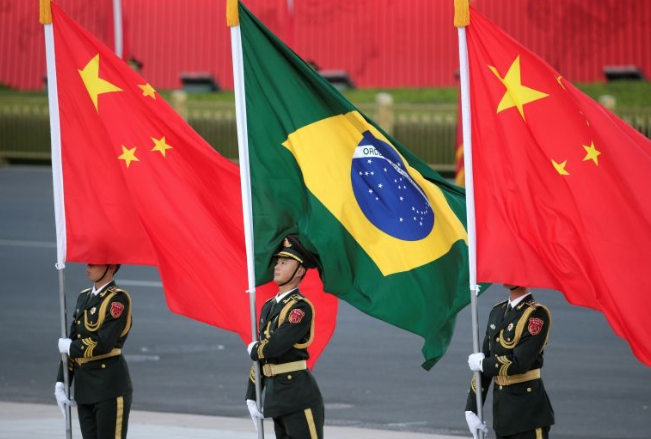
Published 09/21/2024 13:19 | Edited 09/21/2024 13:22
Chinese investments in Brazil totaled US$1.73 billion in 2023, an increase of 33% compared to the previous year. Although the total investment has grown, the amount is the second lowest since 2009, surpassing only the result of 2022, when investments reached US$1.3 billion. Analysis of this and other recent data shows that such investments are not just the result of a spontaneous movement of so-called market forces, but reflect a planned strategy by the Chinese government.
Initially, it is worth noting that this information is part of a report released by the Brazil-China Business Council. According to the document, in 2023, the number of confirmed Chinese projects in the country reached 29 – 9% lower than the total for 2022. Despite the drop, this is the third highest number recorded in the historical series that began in 2007. The realization of the value of Chinese investments in Brazil – that is, the percentage of announced projects that were actually put into practice – rose from 27% to 88% between 2022 and 2023.
Since 2017, the number of Chinese investment projects in Brazil has maintained relatively high levels, varying between 24 and 32 per year – except in 2020, when only eight projects were registered due to the height of the Covid-19 pandemic.
The increase in Chinese investment in Brazil in 2023 occurred despite a 17% drop in foreign investment in the country overall. The electricity sector led the attraction of Chinese investment in Brazil in 2023, with a 39% share in terms of value and 66% in terms of number of projects.
Secondly, the automotive sector accounted for 33% of the amount invested – a 5 percentage point increase in share compared to the previous year. Since 2021, all Chinese projects in the automotive sector in Brazil have been aimed at 100% electric or hybrid vehicles.
Read also: With Lula, Chinese investments in Brazil grow 33%
In 2023, of all Chinese projects in Brazil, 72% were directed to green energy and related sectors – 16 percentage points more than in 2022 and the highest share recorded since the beginning of the historical series in 2007.
Chinese projects in Brazil in 2023 were mainly directed to the Southeast region, which absorbed 68% of the projects, followed by the Northeast (16%), the Central-West (13%) and the South (3%). São Paulo attracted 39% of the Chinese projects in 2023, followed by Minas Gerais, with 29%, and Goiás, with 10%. Bahia and Ceará absorbed 6% of the projects individually, while Mato Grosso do Sul, Rio Grande do Sul and Paraíba each had a share of 3%.
Most Chinese investments entered Brazil in 2023 through greenfield initiatives, with the establishment of new businesses or new rounds of investments in projects previously initiated. This modality represented 83% of the number of ventures and 90% of the value invested.
Chinese productive capital in Brazil
Brazil was the ninth country that received the most Chinese productive capital in 2023, maintaining the same position as the previous year. In recent years, developing countries have attracted the majority of the value invested by China in the world, representing 9 of the 10 main destinations for the Asian country’s investments in 2023.
In Latin America and Brazil, Chinese investments have been less voluminous in recent years, but have been advancing in so-called “new infrastructures”, which include initiatives in areas that are at the heart of Beijing’s development plans, such as renewable energy, electric mobility, information technology, urban infrastructure and high-end manufacturing.
Read also: China with quality development and peace and cooperation policy
The agenda of the power shoringa corporate strategy focused on decarbonization for the production of energy-intensive goods for export, presents a window of opportunity for attracting new Chinese investments in Brazil in industry and in areas linked to the energy transition process, considering the country’s various comparative advantages, such as its clean energy matrix, vast availability of fresh water, its reserves of critical minerals and distance from major contemporary geopolitical issues.
In line with the increase in Chinese investments in Brazil, official figures from China show that the Asian country’s non-financial contributions to the world increased by 11.4% in 2023. Alternatively, UNCTAD and the OECD point to drops of 9.4% and 12%, respectively, in Chinese investments abroad.
Between 2022 and 2023, Chinese investment fell by 36% in the United States, 57% in Australia and 4.2% in the European Union and the United Kingdom, but increased by 37% in the Belt and Road Initiative countries.
In terms of stock, Chinese investments in Brazil between 2007 and 2023 totaled US$73.3 billion, resulting from 264 confirmed projects. The electricity segment absorbed 45% of the total value, followed by the oil extraction area, with 30%. If we consider the number of projects – and not their financial value –, the electricity segment also leads, with 39% of the projects, but the manufacturing industry comes next, with a share of 23%.
The Southeast attracted 54% of the number of Chinese projects in Brazil between 2007 and 2023, followed by the Northeast (16%), Central-West (13%), South (9%) and North (7%) regions. In the analysis by federative unit, São Paulo remains in the lead, with a share of 36.2%.
Infrastructure projects
Another survey conducted by the website Poder 360 reports that infrastructure projects by Chinese companies exceed R$280 billion in Brazil. According to the website, most of these investments are in the energy sector and the company that invests the most in this sector is the Chinese state-owned company State Grid, with investments of around R$200 billion in renewable generation plants and power transmission lines, energy distribution in SP, MG, RS and PR and the Maranhão-Goiás ultra-high voltage transmission line.
Another Chinese state-owned company in the energy sector, Energy China, is investing R$50 billion in renewable energy generation and green hydrogen. Also in the energy sector, the state-owned China Three Gorges, owner of the Ilha Solteira Hydroelectric Plant in São Paulo and 16 other hydroelectric plants in Brazil, is investing R$9.4 billion in new wind and solar plants and power generation at the 17 hydroelectric plants it owns.
In the transportation sector, Chinese state-owned companies CCCC (China Communications Construction Corporation) and CRCC (China Railway Construction Corporation) are investing US$24 billion in the São Paulo-Campinas intercity train and the Salvador-Itaparica Bridge. Finally, Cnooc (China National Offshore Oil Corporation), one of the three Chinese state-owned companies in the oil sector, is investing R$100 million in oil exploration and research in three blocks.
Considerations
The data released by the two surveys give rise to a number of considerations. The first is that for some years now, Chinese industrial investments, whether in the manufacturing sector or in the area of public utility industrial services, namely energy generation and distribution activities, have been increasing consistently. The second is that a significant part of these investments are being made by Chinese state-owned companies.
This leads us to conclude that such investments are not just the result of a spontaneous movement of so-called market forces, but reflect a planned strategy of the Chinese government, whether in the sense of strengthening its cooperation ties with developing countries in general, or with Brazil in particular, or in the sense of finding alternatives for the global expansion of Chinese companies in the face of growing restrictions on Chinese direct investment in the United States and Europe.
These facts should not go unnoticed by the Brazilian government, which should seize the opportunity to leverage Brazil’s industrial development project launched in January 2024 called “New Industry Brazil”. Given the tendency of the United States, a traditional foreign investor in Brazil, to take back many North American companies that over the last decades have transferred part of their manufacturing operations to developing countries, Brazil should negotiate, as part of a possible accession to the Chinese Belt and Road project, the main vehicle for the internationalization of the Chinese economy, a broad agreement for Chinese industrial investments in the country, particularly in the high and medium-high technology sectors.
Instead of just passively awaiting announcements of Chinese investments, the Brazilian government should act proactively to attract these investments to the areas of greatest interest to the country. This could be done within the scope of COSBAN (Sino-Brazilian High-Level Commission for Coordination and Cooperation), which, on the Brazilian side, is coordinated by the Vice President of the Republic, Geraldo Alkimin, who, coincidentally, is the Minister of Development, Industry, Commerce and Services. One model that could be followed is the same one implemented in the first Lula administration, when, within the scope of the Civil House of the Presidency of the Republic, under the coordination of then Minister José Dirceu, a specialized office was created composed of representatives from various ministries with the objective of facilitating the arrival of foreign investments to the country.
Editing: Priscila Lobregatte
Source: vermelho.org.br

